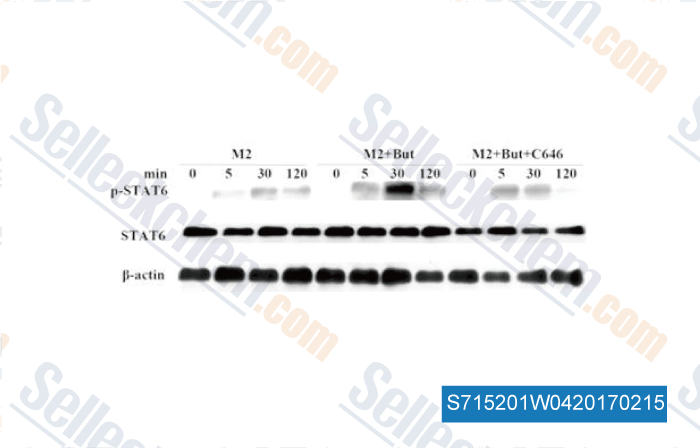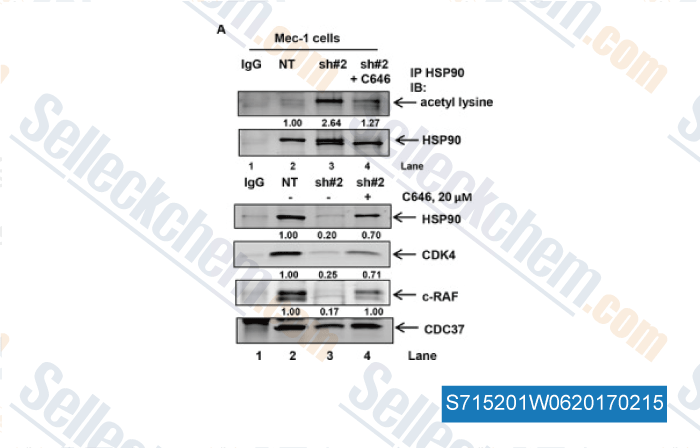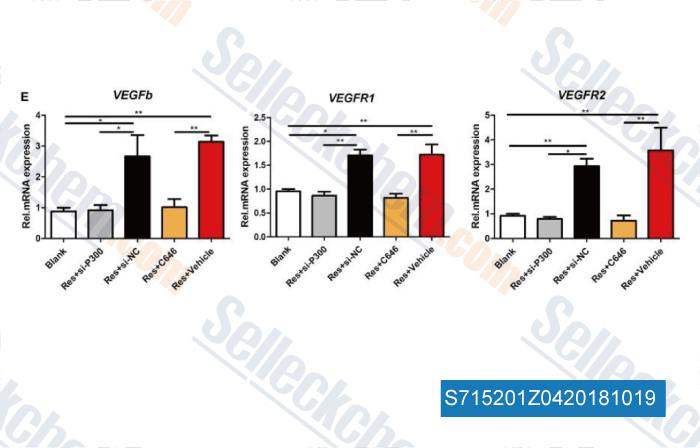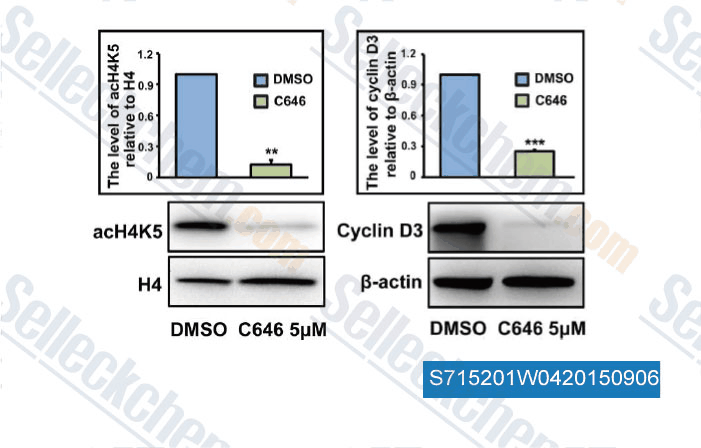|
Toll Free: (877) 796-6397 -- USA and Canada only -- |
Fax: +1-832-582-8590 Orders: +1-832-582-8158 |
Tech Support: +1-832-582-8158 Ext:3 Please provide your Order Number in the email. |
Technical Data
| Formula | C24H19N3O6 |
||||||
| Molecular Weight | 445.42 | CAS No. | 328968-36-1 | ||||
| Solubility (25°C)* | In vitro | DMSO | 13 mg/mL (29.18 mM) | ||||
| Water | Insoluble | ||||||
| Ethanol | Insoluble | ||||||
| In vivo (Add solvents to the product individually and in order) |
|
||||||
|
* <1 mg/ml means slightly soluble or insoluble. * Please note that Selleck tests the solubility of all compounds in-house, and the actual solubility may differ slightly from published values. This is normal and is due to slight batch-to-batch variations. * Room temperature shipping (Stability testing shows this product can be shipped without any cooling measures.) |
|||||||
Preparing Stock Solutions
Biological Activity
| Description | C646 is an inhibitor for histone acetyltransferase, and inhibits p300 with a Ki of 400 nM in a cell-free assay. Preferentially selective for p300 versus other acetyltransferases. This compound induces cell cycle arrest, apoptosis and autophagy. | ||
|---|---|---|---|
| Targets |
|
||
| In vitro | C646 is an inhibitor for histone acetyltransferase, inhibits p300 with a Ki of 400 nM and is selective versus other acetyltransferases. This compound produces 86% inhibition of p300 in vitro at 10 μM. It is a classical reversible p300 inhibitor. This chemical treatment (25μM) reduces histone H3 and H4 acetylation levels and abrogates TSA-induced acetylation in cells. [1] It (20μM) induces apoptosis in androgen-sensitive and castration-resistant prostate cancer cell lines by interfering with AR and NF-kB pathways. [2] This compound blocks dynamic acetylation of H3K4me3 globally in mouse and fly cells, and locally across the promoter and start-site of inducible genes in the mouse, thereby disrupting RNA polymerase II association and the activation of these genes. [3] | ||
| In vivo | C646 infused into the ILPFC immediately after weak extinction training enhances the consolidation of fear extinction memory. [4] This compound attenuates mechanical allodynia and thermal hyperalgesia, accompanied by a suppressed COX-2 expression, in the spinal cord. [5] | ||
| Features | Extensively used as a pharmacologic probe in cancer cells. Potential use for prostate and lung cancers. |
Protocol (from reference)
| Kinase Assay:[1] |
|
|---|---|
| Cell Assay:[1] |
|
| Animal Study:[4] |
|
References
|
Customer Product Validation

-
Data from [ , , Sci Rep, 2016, 6:24838. ]

-
Data from [ , , Oncotarget, 2015, 6(31):31767-79. ]

-
Data from [ , , Front Neurosci, 2018, doi:10.3389/fnins.2018.00341 ]

-
Data from [ , , Biol Reprod, 2015, 93(1): 13 ]
Selleck's C646 Has Been Cited by 125 Publications
| TIGIT deficiency promotes autoreactive CD4+ T-cell responses through a metabolic‒epigenetic mechanism in autoimmune myositis [ Nat Commun, 2025, 16(1):4502] | PubMed: 40374622 |
| Alleviation of liver fibrosis by inhibiting a non-canonical ATF4-regulated enhancer program in hepatic stellate cells [ Nat Commun, 2025, 16(1):524] | PubMed: 39789010 |
| Extracellular Histones as Exosome Membrane Proteins Regulated by Cell Stress [ J Extracell Vesicles, 2025, 14(2):e70042] | PubMed: 39976275 |
| Loss of p300 in proximal tubular cells reduces renal fibrosis and endothelial-mesenchymal transition [ EMBO Mol Med, 2025, 17(7):1575-1598] | PubMed: 40588562 |
| Lactylation modification of HIF-1α enhances its stability by blocking VHL recognition [ Cell Commun Signal, 2025, 23(1):364] | PubMed: 40760493 |
| Herbal-based Xuebijing injection ameliorated vascular endothelial dysfunction via inhibiting ACLY/MYB/RIG-I axis in sepsis-associated lung injury [ Phytomedicine, 2025, 140:156573] | PubMed: 40088739 |
| Nuclear PD-L1 triggers tumour-associated inflammation upon DNA damage [ EMBO Rep, 2025, 10.1038/s44319-024-00354-9] | PubMed: 39747659 |
| Histone acetylation facilitates multidirectional pulp repair through Neuregulin-1 mobilization [ Stem Cells Transl Med, 2025, 14(7)szaf022] | PubMed: 40580029 |
| Matrix stiffness induced gallbladder fibroblasts activation and paracrine SEMA7A promotes gallbladder cancer cell epithelial-mesenchymal transition and cancer stem cell-like properties by modulating AKT/p300 signalling [ Biol Direct, 2025, 20(1):93] | PubMed: 40830485 |
| Knockdown of ACC1 promotes migration and invasion of U251 glioma cells by epigenetically suppressing SDH [ Int J Oncol, 2025, 67(3)73] | PubMed: 40747663 |
RETURN POLICY
Selleck Chemical’s Unconditional Return Policy ensures a smooth online shopping experience for our customers. If you are in any way unsatisfied with your purchase, you may return any item(s) within 7 days of receiving it. In the event of product quality issues, either protocol related or product related problems, you may return any item(s) within 365 days from the original purchase date. Please follow the instructions below when returning products.
SHIPPING AND STORAGE
Selleck products are transported at room temperature. If you receive the product at room temperature, please rest assured, the Selleck Quality Inspection Department has conducted experiments to verify that the normal temperature placement of one month will not affect the biological activity of powder products. After collecting, please store the product according to the requirements described in the datasheet. Most Selleck products are stable under the recommended conditions.
NOT FOR HUMAN, VETERINARY DIAGNOSTIC OR THERAPEUTIC USE.
